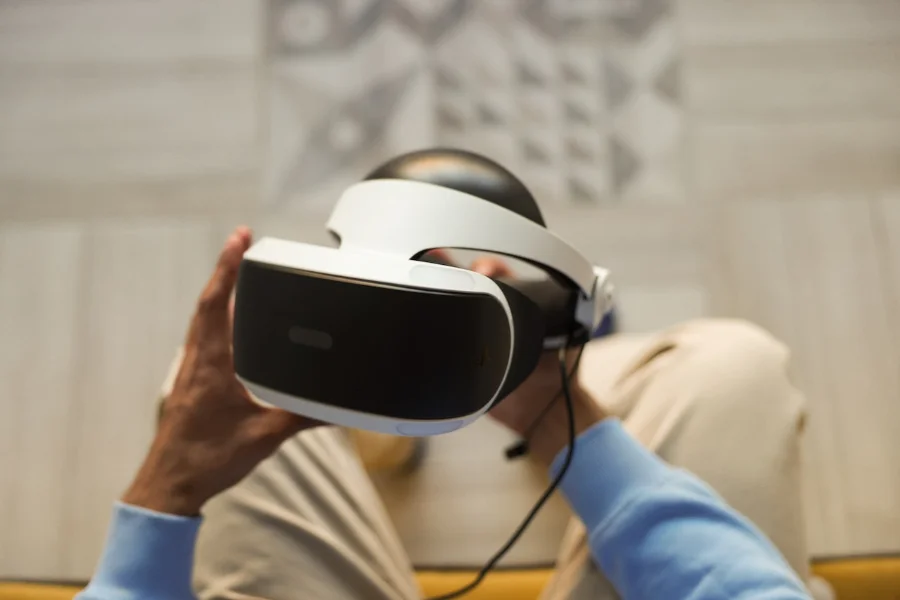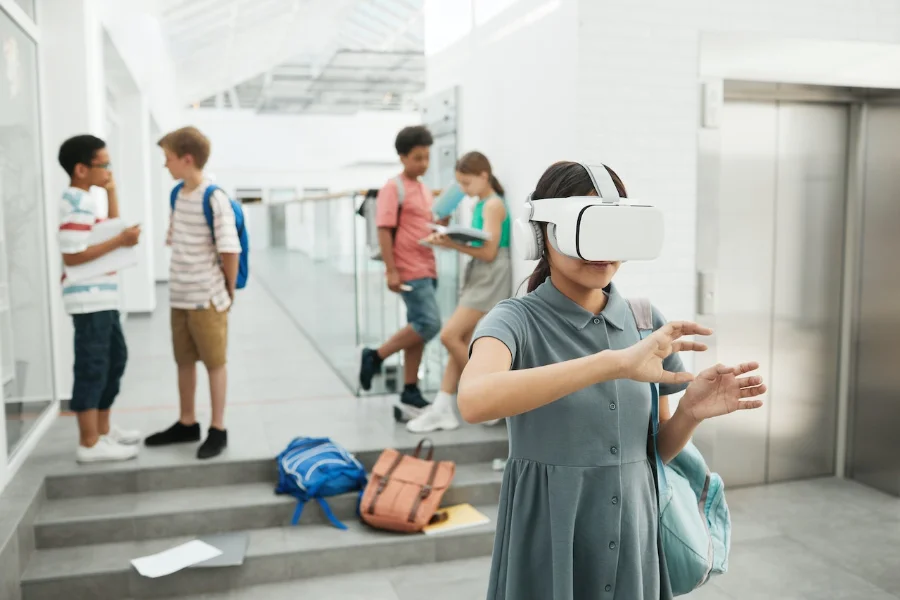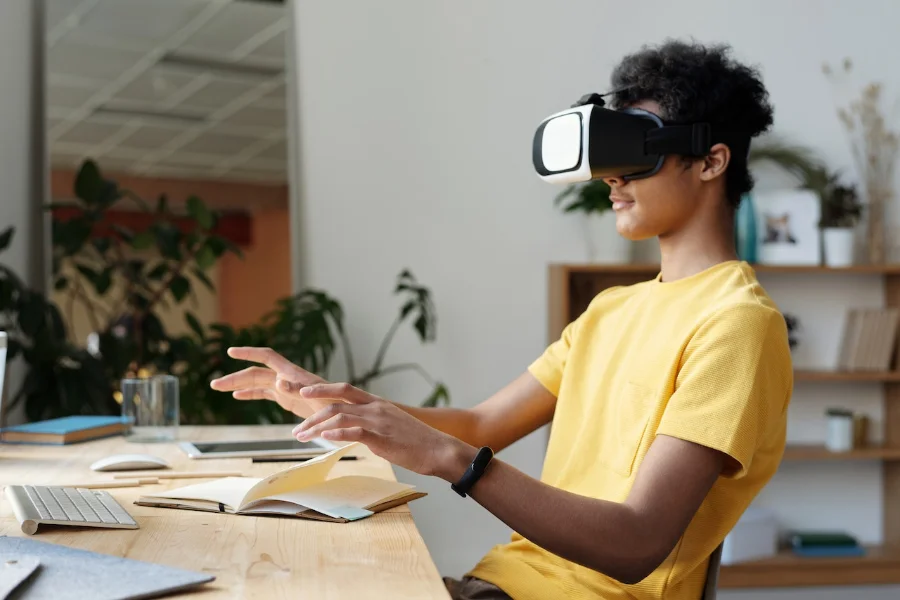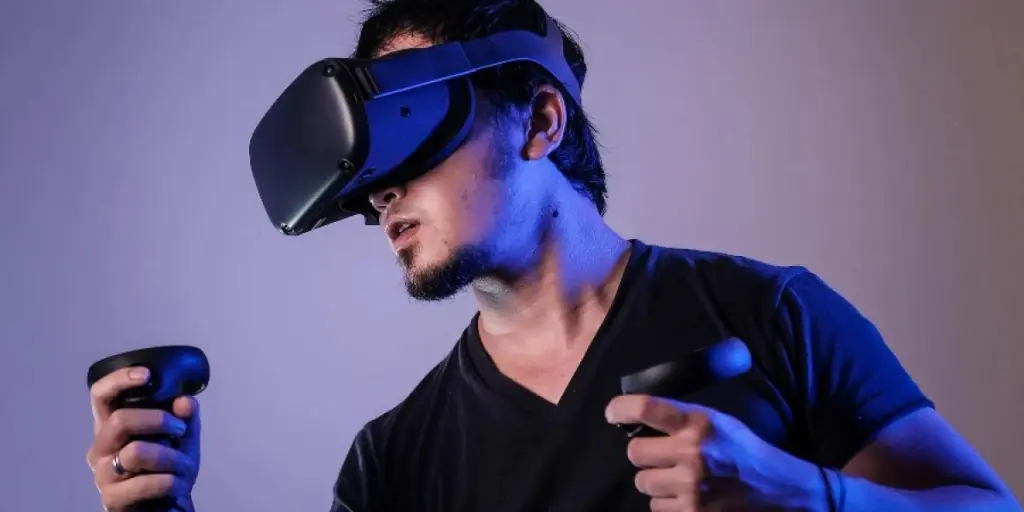Virtual Reality (VR) has emerged as a groundbreaking technology, transporting us to extraordinary digital realms and transforming how we experience entertainment, education, and various industries. VR headsets are at the forefront of this immersive revolution, the gateway to captivating virtual experiences.
Join us as we uncover the key components, features, and considerations when purchasing a VR headset. By understanding these factors, you can guide your customers to make informed decisions when purchasing VR headsets. Together, let’s unlock virtual reality’s immense potential and power as we embark on an immersive journey into the exciting world of VR headsets.
Table of Contents
The market for VR headsets
What is virtual reality?
Applications and industries benefiting from VR headsets
Understanding VR headsets
Factors to consider when buying a VR headset
What specs should you look for when purchasing a VR headset?
Accessories to sell alongside VR headsets
Challenges and opportunities in the VR headset market
The future of VR headsets
The market for VR headsets
The global market for virtual reality headsets was worth around US$ 7.77 billion in 2022 and is projected to grow at 30.6% annually from 2023 to 2030. Asia Pacific is expected to register the highest CAGR of over 32.9% due to the increased digitalization and technology developments, particularly in gaming and entertainment.
The high-end virtual reality devices, known for their advanced features and superior performance, dominated the market with over 57% revenue share in 2022 and are expected to maintain their dominance. These devices are primarily used by big corporations to offer high-quality services to their customers and employees. Continuous investments by major players like HP Inc., Facebook Technologies (Oculus), and Google contribute to the demand for high-end devices.
On the other hand, low-end VR devices are projected to experience the highest growth rate, with a CAGR of around 35.3% from 2023 to 2030. These devices are affordable and provide a considerable immersive experience, making them accessible to a wider range of users. Many people opt for low-end devices to experience basic VR technology, often utilizing their smartphones as the main component.
Standalone VR devices, which integrate processing control and hardware into a single system, accounted for the largest revenue share of over 44% in 2022 and are expected to continue their dominance. These devices offer high-quality experiences at an affordable price, with various application-oriented options available in the market.
The smartphone-enabled VR devices, driven by the increasing adoption of VR-enabled smartphones with advanced 3D technology and AI integration, are anticipated to exhibit a significant CAGR of 33.1% during the forecast period. These headsets are easily accessible and widely available, making them popular among smartphone users.
Overall, the market for VR headsets is diverse, with high-end devices leading in revenue share, low-end devices showing rapid growth, and both standalone and smartphone-enabled devices catering to different user preferences and needs.
Major players in the VR headset market
The VR headset market has several major players who have made significant contributions to the development and advancement of virtual reality technology. Some of the prominent companies in this space include:
- Oculus: Oculus, owned by Facebook, is known for its Oculus Rift series of VR headsets. They have been pioneers in the consumer VR market and have released various iterations of their headsets, including the Oculus Rift, Oculus Rift S, and Oculus Quest series.
- HTC Vive: Developed by HTC in collaboration with Valve Corporation, the HTC Vive is a high-end VR headset known for its room-scale tracking and immersive experience. It offers precise tracking and has a strong ecosystem of games and applications.
- Sony PlayStation VR: Sony’s PlayStation VR is a VR headset designed specifically for the PlayStation gaming console. It provides a VR experience that integrates with the PlayStation gaming ecosystem, making it accessible to a large user base.
- Valve Index: The Valve Index is a premium VR headset developed by Valve Corporation. It offers high-resolution displays, precise tracking, and advanced controllers, providing a high-fidelity and immersive VR experience for gaming and other applications.
- Samsung Gear VR: A smartphone-based VR headset developed by Samsung in partnership with Oculus. It uses Samsung’s smartphones as the display and processing unit, providing an affordable entry point into virtual reality.
- Pico Interactive: Pico Interactive focuses on standalone VR headsets. They offer a range of all-in-one VR headsets, such as the Pico Neo series, which provide a wireless and untethered VR experience.
- Microsoft HoloLens: While not strictly a VR headset, Microsoft HoloLens is an augmented reality (AR) headset with significant implications for mixed reality experiences. It blends virtual content with the real world, enabling users to interact with holographic objects.
These are just a few examples of the major players in the VR headset market. It’s worth noting that the industry is constantly evolving, and new players and technological advancements continue to shape the market landscape.

What is virtual reality?
Virtual reality refers to a simulated experience similar to or completely different from the real world. It involves using computer technology, usually through a headset or other immersive devices, to create an artificial environment that users can interact with and experience as if they were physically present within it.
VR typically utilizes a combination of visual, auditory, and sometimes haptic (touch) feedback to provide a multisensory experience. By wearing a VR headset, users are transported into a three-dimensional virtual world that can be pre-designed or generated in real time. The user’s movements and actions are tracked, allowing them to navigate and interact with the virtual environment.
Virtual reality can offer a wide range of experiences, from simple 3D visualizations to complex and interactive simulations. It has gained significant popularity in various fields, including gaming, entertainment, education, training, healthcare, architecture, and more. The immersive nature of VR allows users to feel fully engaged and immersed in virtual worlds, creating a sense of presence and enabling unique experiences that would be difficult or impossible to achieve in the physical world.

Applications and industries benefiting from VR headsets
When you think about virtual reality, the first thing that comes to mind is probably gaming (or maybe some other type of entertainment), but VR has applications in various industries outside of entertainment.
Gaming and entertainment
Of course, VR headsets have significantly impacted the gaming industry, offering immersive and interactive experiences. Players can enter virtual worlds, engage in realistic gameplay, and feel a greater sense of presence. VR gaming extends beyond traditional genres and allows for unique experiences, such as virtual escape rooms, simulation games, and multiplayer VR experiences.
Education and training
VR has immense potential in education and training. It enables immersive learning experiences, allowing students to explore historical sites, participate in virtual field trips, and engage in interactive simulations. VR can also be used for skills training, such as medical procedures, hazardous environments, or professional development scenarios.
Healthcare and therapy
VR can assist in pain management, distraction during medical procedures, and exposure therapy for phobias and anxiety disorders. Virtual reality is also used for training healthcare professionals, surgical simulations, and rehabilitation exercises.
Architecture and design
VR is transforming the architecture and design industries by providing virtual walkthroughs of architectural designs and interior spaces. It allows architects and clients to visualize and experience designs before construction. VR helps evaluate scale, proportions, and spatial relationships, enhancing the design process.
Tourism and travel
VR headsets enhance the travel experience by offering virtual tours of popular destinations and landmarks. Travelers can explore different locations, experience cultural heritage sites, and preview accommodations and attractions. VR also enables tourism marketing by providing immersive promotional content.
These are just a few examples of how VR headsets are being applied across various industries. The versatility of virtual reality technology opens up new possibilities for enhancing user experiences and transforming how we engage with different sectors.
Understanding VR headsets
Virtual reality headsets come in different types, each offering unique features and functionalities. The three main types of VR headsets are tethered, standalone, and smartphone-based. To understand the magic behind these devices, let’s delve into the key components and features that make VR headsets such powerful gateways to virtual realms.
- Display and resolution: High-resolution displays for each eye ensure crisp and detailed visuals. At the same time, optimal pixel density and refresh rate contribute to smooth and realistic imagery. Additionally, a wide field of view (FOV) expands the virtual world’s scope, making it feel more expansive and immersive.
- Tracking technology: three types of tracking impact the virtual reality experience:
- Head tracking employs sensors or cameras to monitor head movements, allowing the virtual environment to respond in real time.
- Positional tracking goes a step further, tracking physical movements to provide a more precise and natural interaction within the virtual space.
- Room-scale tracking, you can physically explore the virtual world by moving within a designated play area, elevating the level of immersion to new heights.
- Controllers and input methods: VR headsets come equipped with controllers as the gateway to interact with the virtual environment. These handheld devices enable you to manipulate virtual objects, navigate menus, and execute actions. Some systems even support gestural input, empowering you to control actions through hand or body movements. And for the ultimate hands-free experience, voice commands allow you to interact with the virtual world using spoken instructions.
- Audio and immersive sound: Sound is vital in creating a truly immersive VR experience. Spatial audio technology recreates 3D soundscapes, providing a sense of direction and depth. Integrated headphones or audio systems deliver high-quality audio directly to your ears, enriching your virtual adventure with realistic and captivating sound effects.
- Comfort and ergonomic design: Extended VR sessions call for comfort and a design that won’t strain your neck or head. VR headsets with adjustable straps and headbands ensure a secure and comfortable fit for users of all head sizes and shapes. Lightweight and balanced designs reduce the strain on your head, allowing you to explore virtual worlds for longer periods without discomfort. Proper ventilation and heat management prevent heat buildup, ensuring a cool and enjoyable experience. Some headsets also accommodate users with prescription eyeglasses, providing the flexibility for a clear and comfortable view.
Regardless of the type of VR headset, the basic principle of operation remains the same. The headset delivers separate images to each eye to create a 3D stereoscopic effect. The motion tracking sensors or cameras monitor the user’s head movements and adjust the displayed images accordingly, ensuring an immersive and responsive experience. Controllers or input devices allow users to interact with the virtual environment, enabling actions such as grabbing objects, pressing buttons, or navigating through menus.
Now, let’s delve into the main types of headsets, how they differ, and why one may choose one type over another.
Tethered VR headsets
Tethered VR headsets require a connection to a powerful computer or gaming console. They offer high-end performance and immersive experiences. These headsets typically consist of a head-mounted display (HMD), motion tracking sensors, and handheld controllers.
- The HMD contains high-resolution displays for each eye, providing a stereoscopic 3D view.
- The motion tracking sensors, often external cameras or infrared sensors, track the user’s movements and position in real time, allowing them to interact with the virtual environment.
Tethered headsets also offer advanced features like room-scale tracking, where users can move around a designated play area.
Standalone VR headsets
Standalone VR headsets are self-contained and do not require a connection to a computer or console. They have built-in processors, displays, and motion-tracking capabilities, providing a more convenient and portable VR experience.
Standalone headsets typically have integrated sensors and cameras that track the user’s head movements and position. They may include controllers for interaction, which can be tracked through built-in sensors or external cameras. Standalone headsets are ideal for users who want to experience VR without additional hardware or wires.

Smartphone-based VR headsets
Smartphone-based VR headsets utilize a smartphone as the primary display and processing unit. These headsets are generally affordable and accessible options for entry-level VR experiences.
Users insert their smartphones into the headset, which holds the device in front of their eyes. The smartphone screen acts as the display, and dedicated VR apps or games provide the virtual environment.
Smartphone-based headsets often incorporate lenses that help focus and separate the screen into two images for a stereoscopic effect. Some models include additional sensors, such as accelerometers, gyroscopes, or external controllers, to enable basic motion tracking.
Factors to consider when buying a VR headset
With a wide range of options available, it’s important to consider several factors before investing in a VR headset. Let’s explore the key considerations to help you make an informed decision.
Budget and price range
Determining your budget is a crucial starting point. VR headsets vary in price, with options available for different budget ranges. Decide on a comfortable spending limit and explore the options within that range to find the best value for your money.
Compatibility with existing devices and platforms
Check the compatibility of the VR headset with your existing devices and platforms. Some headsets require powerful computers or gaming consoles, while others are standalone devices or smartphone-based. Ensure that your device and operating system are compatible to avoid issues.
Use case and intended applications
Consider your intended use for the VR headset. Are you primarily interested in gaming, education, professional applications, or entertainment? Different headsets excel in specific areas, so identifying your primary use case will help you choose a headset that suits your needs.
Comfort and ergonomics
Comfort is key, especially for longer VR sessions. Look for headsets with adjustable straps, headbands, and cushioning that provide a secure and comfortable fit. Consider the weight and balance of the headset to prevent strain on your neck and head. Opt for models with proper ventilation to avoid discomfort caused by heat buildup.
Content library and ecosystem
Explore the available content library and ecosystem associated with the VR headset. Check for a diverse range of applications, games, and experiences that align with your interests. A robust content library ensures ongoing enjoyment and value from your VR headset.
Reviews and recommendations
Research customer reviews and recommendations from reputable sources. Seek feedback from VR enthusiasts or communities to gain insights into the performance, user experience, and potential issues associated with different headsets. Real-world experiences can help you make a more informed decision.
What specs should you look for when purchasing a VR headset?
Looking for more specifics? There are a few specs to look at when purchasing a VR headset.
- Refresh rate: The refresh rate is how often the screen updates per second (i.e. how often it refreshes). We recommend at least 90 Hz as lower refresh rates might cause nausea and dizziness.
- Display and resolution: Look for a high-resolution display for each eye. Higher resolutions, such as 1080 x 1200 or higher, provide clearer and more detailed visuals, reducing the screen-door effect and enhancing immersion.
- Field of view (FOV): A wider FOV allows for a more immersive experience by expanding your peripheral vision. Look for headsets with FOV specifications of around 100 degrees or more.
- Connectivity and ports: Check for connectivity options such as USB, HDMI, or wireless capabilities, depending on your preferences and requirements.
Accessories to sell alongside VR headsets
If your business sells VR headsets, there are several accessories you can also carry that will improve the experience of buyers and provide additional value:
- VR controllers: Selling additional or upgraded VR controllers can give users more control and interactivity in their virtual experiences. These controllers may offer improved ergonomics, extra buttons, or enhanced tracking capabilities. There are also accessories, such as non-slip covers for controllers, that increase comfort and decrease the likelihood of dropping or throwing the controller.
- VR sensor stands: Providing dedicated stands or mounts for VR sensors can help users set up their VR systems more conveniently. These stands can ensure optimal sensor positioning for accurate tracking and ease of use. Stands can also be used for charging.
- Protective cases: VR headsets are delicate and prone to damage during storage or transport. Offering protective cases or carrying bags designed for VR headsets can help users safeguard their investments.
- Replacement cables and adapters: Selling spare cables and adapters can be useful for users needing replacements due to wear and tear or compatibility issues. It ensures uninterrupted VR experiences and saves users the hassle of searching for compatible accessories.
- VR face covers: Providing different types of face covers or foam replacements can improve hygiene and comfort during extended VR sessions. These accessories can be easily cleaned or replaced, catering to users’ preferences and ensuring a more personalized fit. Additionally, head straps can be purchased for increased comfort.
- VR cable management solutions: Cable management systems, such as retractable cable holders or ceiling-mounted hooks, can help users manage VR headset cables, reducing tangling and improving freedom of movement.
- VR lenses and lens protectors: Offering replacement lenses, blue light lenses, or lens protectors can help users maintain the clarity and quality of their VR visuals. These accessories can protect against scratches and extend the lifespan of the headset.
By offering a range of accessories alongside VR headsets, businesses can provide users with a comprehensive VR ecosystem, enhance the user experience, and create additional revenue streams. Additionally, providing reliable customer support and guidance on accessory compatibility can further strengthen customer satisfaction and loyalty.

Challenges and opportunities in the VR headset market
The virtual reality headset market is dynamic and rapidly evolving, presenting challenges and exciting opportunities for businesses and consumers. Understanding the current challenges and recognizing the potential opportunities can help stakeholders navigate this market effectively.
Price and affordability considerations
- Challenge: The cost of VR headsets remains a barrier to widespread adoption, particularly for budget-conscious consumers.
- Opportunity: Increasing competition and technological advancements reduce prices, making VR headsets more accessible. Manufacturers can focus on developing affordable options without compromising quality, catering to a larger consumer base.
Technological limitations and advancements
- Challenge: VR headsets face technological limitations such as screen resolution, field of view, and processing power, which can impact the immersive experience.
- Opportunity: Technological advancements, including higher-resolution displays, wider FOV, and improved processing capabilities, present opportunities for manufacturers to enhance the overall VR experience. Continued innovation and research can push the boundaries of what VR headsets offer.
User experience and content availability
- Challenge: User comfort, motion sickness, and limited content availability can impact the adoption and retention of VR headsets.
- Opportunity: Improving user comfort through ergonomic designs, reducing motion sickness through better tracking technology, and expanding the content library with engaging and diverse experiences can enhance the overall user experience. Collaboration with content developers and creators can drive the availability of captivating VR content.
Potential impact of augmented reality (AR) on the market
- Challenge: The rise of AR technologies challenges the VR headset market as AR offers a different, more blended reality experience.
- Opportunity: VR headset manufacturers can explore opportunities to integrate AR functionalities into their devices, creating a hybrid experience that combines the best of both worlds. Additionally, targeting specific use cases where VR excels, such as gaming and immersive simulations, can help differentiate VR headsets from AR devices.
Future prospects and emerging trends
- Challenge: The VR headset market is constantly evolving, and keeping up with emerging trends and consumer demands can be challenging.
- Opportunity: Identifying and capitalizing on emerging trends such as social VR, location-based VR experiences, and advancements in wireless and standalone technologies can position manufacturers and businesses at the forefront of the VR headset market. Continuous market research and adaptability are crucial in seizing emerging opportunities.
The VR headset market is a vibrant and promising industry but faces its fair share of challenges. By addressing affordability, improving technology, enhancing user experience, adapting to AR developments, and staying ahead of emerging trends, stakeholders in the VR headset market can unlock significant opportunities for growth and innovation. As the market continues to evolve, it holds the potential to reshape entertainment, education, healthcare, and various other sectors, offering immersive and transformative experiences for users worldwide.

The future of VR headsets
The future of the VR market looks promising, with significant growth expected in the coming years. Advancements in technology, decreasing costs, and expanding content libraries are driving increased adoption. VR is becoming more accessible with the development of standalone and wireless headsets, making it convenient and affordable for a broader range of consumers.
The applications of VR are diversifying beyond gaming and entertainment, extending into sectors like healthcare, education, architecture, training, and tourism. As technology advances, VR experiences will become more immersive and realistic, with higher resolutions, wider fields of view, and advanced audio. Integrating VR with augmented reality (AR) is an emerging trend, blending virtual and real worlds.
To stay relevant and beat the competition in VR headsets, businesses should consider a few key factors. First, they should focus on product innovation, continuously improving their headsets’ hardware, comfort, and input methods. Offering a diverse range of options to cater to different consumer needs and preferences is crucial.
Second, businesses should prioritize content development and partnerships. A robust and diverse library of compelling VR experiences and applications will attract consumers and create long-term engagement.
Third, businesses should stay updated with emerging technologies and trends, such as AR integration, to ensure they remain at the forefront of innovation.
Finally, providing excellent customer support, investing in marketing and branding efforts, and maintaining competitive pricing will contribute to success in the market.
By considering these factors, businesses can position themselves effectively, differentiate from competitors, and meet the evolving demands of the VR market, securing a strong foothold in this transformative industry.




